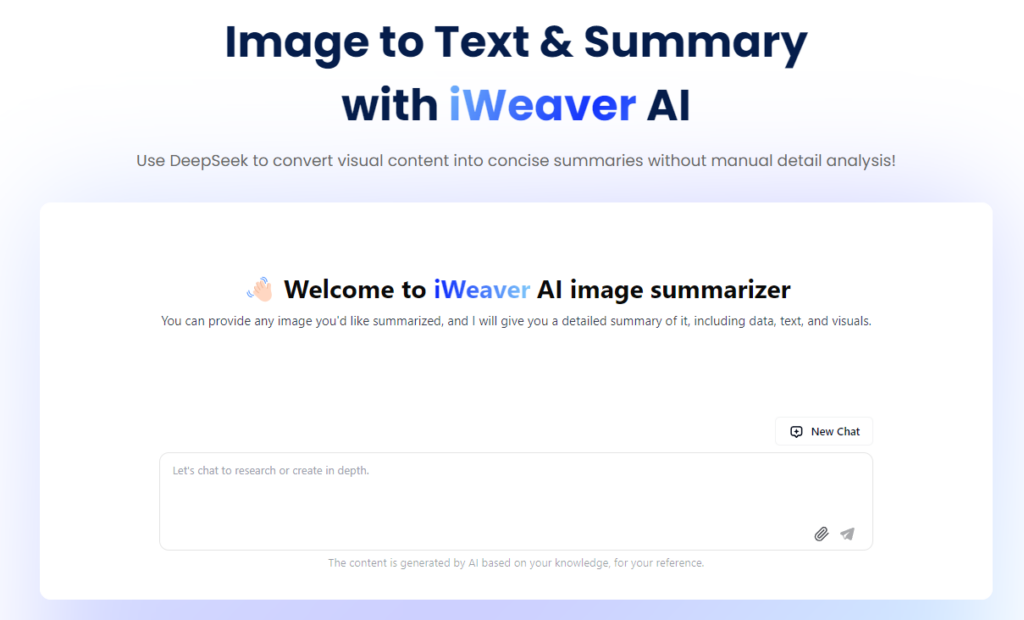In today’s digital age, the sheer volume of visual content being created and shared every day is staggering. From social media posts to marketing materials, images play a crucial role in communication. However, many people struggle to efficiently comprehend the large quantities of images they encounter on a daily basis. This is where image summarizing tools come into play. These tools are designed to process, analyze, and extract key details from images, providing users with a concise summary that can be quickly understood.
In this article, we’ll dive into the concept of image summarization, how it works, its applications, and the top image summarizing tools available today. We’ll also highlight the benefits and potential drawbacks of these tools and how they are revolutionizing various industries, from digital marketing to education and research.
What is Image Summarization?
Image summarization refers to the process of analyzing and condensing the content of an image into a more digestible and concise summary. This is often achieved through artificial intelligence (AI) and machine learning (ML) techniques that help the software identify objects, texts, and key visual features within an image. The goal is to provide users with an accurate, easy-to-understand summary without them needing to manually interpret or process the image.
Image summarizers use advanced algorithms to break down the content, reducing unnecessary details while preserving the core meaning of the image. In essence, they allow users to grasp the key information in a fraction of the time.
How Do Image Summarizing Tools Work?
Image summarizing tools employ various methods to analyze and summarize images. These methods typically involve the use of computer vision, deep learning, and natural language processing (NLP). Let’s take a closer look at the process:
1. Image Recognition
The first step in summarizing an image is identifying the objects, people, and context within the image. AI-based image recognition models are trained to detect patterns, shapes, and textures that signify specific items, like a car, a tree, or a face. This is done by applying deep learning techniques to extract features from the image.
2. Data Extraction
Once the objects in the image are recognized, the tool extracts relevant information, such as descriptions of the objects or the overall theme of the image. For example, if the image contains a city street scene, the summarizer might extract details like “urban environment,” “busy street,” “vehicles,” or “pedestrians.”
3. Contextual Analysis
Beyond object recognition, contextual analysis plays a crucial role in summarization. This involves understanding the relationships between the objects and the surrounding environment. For instance, an image of a man in a park can be summarized as “a person relaxing in a green space,” taking into account the setting and the individual’s action.
4. Summary Generation
Finally, the tool generates a summary by combining the extracted data with predefined rules or templates. The result is a concise description that highlights the most important elements of the image, helping users quickly understand the key message.
Key Advantages of Image Summarizing Tools
Using an image summarizing tool offers several benefits, particularly for businesses, researchers, educators, and everyday users. Some of the main advantages include:
1. Time Efficiency
With the help of image summarizers, users can quickly process large quantities of images without having to manually sift through them. For professionals working with extensive image databases, such as marketers or researchers, this is especially valuable.
2. Improved Decision-Making
When images are summarized in a clear and concise manner, decision-makers can make more informed choices faster. For example, an e-commerce business can use image summaries to quickly identify trends in product images and make marketing decisions based on visual content.
3. Enhanced Accessibility
Image summarizing tools make visual content more accessible to people with disabilities, such as the visually impaired. By providing detailed descriptions of images, these tools help ensure that visual content can be understood by a wider audience.
4. Better Organization
For businesses and institutions managing large volumes of images, an image summarizer can help categorize and organize content efficiently. Summaries can be tagged and indexed, making it easier to search for and retrieve images based on specific criteria.
Key Disadvantages of Image Summarizing Tools
While image summarization tools offer numerous benefits, there are some potential limitations and challenges associated with their use. Here are a few drawbacks to consider:
1. Lack of Contextual Understanding
Despite advances in AI, current image summarizing tools may still struggle to fully understand complex contexts. For example, an image with ambiguous content may not always be accurately summarized, leading to misleading or incomplete summaries.
2. Dependence on AI and Algorithms
The quality of summaries depends largely on the algorithms and AI models used. If the tool’s AI is not sufficiently trained or is flawed, it may produce inaccurate or incomplete summaries, which can be detrimental, especially in critical applications like healthcare or law.
3. Cost and Accessibility
Some of the more advanced image summarizing tools may come with a hefty price tag, making them inaccessible for smaller businesses or individual users. While there are free tools available, they often come with limited functionality.
4. Privacy Concerns
Since image summarizing tools process visual content, privacy and data security could be an issue, especially for sensitive images. It’s important for users to ensure that the tool they use complies with data protection regulations.
Top Image Summarizing Tools in 2025
There are several image summarizing tools on the market today, each offering unique features and capabilities. Here are some of the top tools that stand out:
1. iWeaver
iWeaver offers a free image summarizer tool that allows quick processing of images into concise summaries. It is user-friendly and ideal for students looking to enhance their study sessions.

2. Google Vision AI
Google Vision AI is one of the leading tools for image recognition and summarization. With its powerful image analysis capabilities, this tool can identify and summarize objects, text, and other key elements within an image. Google Vision AI uses machine learning to improve its accuracy over time, making it an excellent choice for businesses and developers.
3. Clarifai
Clarifai is another AI-powered tool that specializes in image and video recognition. It provides users with accurate image summaries and can be customized for specific industries, such as retail or security. Clarifai also offers a range of AI models for different types of content analysis, including facial recognition and product detection.
4. Microsoft Azure Computer Vision
Microsoft’s Azure platform offers computer vision services that include image summarization, text recognition, and object identification. With its cloud-based infrastructure, Azure allows users to scale their image summarization needs and integrate the tool into existing systems.
5. IBM Watson Visual Recognition
IBM Watson’s Visual Recognition tool is designed to analyze images, identify objects, and generate summaries based on the recognized content. It also offers the ability to train custom models for more specific image analysis tasks, making it a great option for businesses with specialized needs.
6. DeepAI
DeepAI offers a free, user-friendly image summarization tool that utilizes deep learning algorithms. The tool can process and summarize various types of images, from portraits to complex scenes, and is known for its accuracy and ease of use.
Applications of Image Summarization
Image summarizers have wide-ranging applications in various industries. Here are a few key areas where these tools are making a significant impact:
1. Marketing and Advertising
For marketers, understanding and analyzing visual content is essential. Image summarization tools can help businesses quickly evaluate the effectiveness of their visual assets and identify trends in consumer behavior based on images.
2. Education
Educators use image summarizers to create accessible content for students. Whether it’s summarizing diagrams, charts, or images in textbooks, these tools make learning materials more engaging and understandable for all students.
3. Healthcare
In healthcare, image summarization is crucial for efficiently analyzing medical images, such as X-rays, MRIs, and CT scans. By summarizing these complex images, doctors and medical professionals can make faster and more accurate diagnoses.
4. Social Media and Content Curation
Social media platforms and content aggregators rely on image summarization to curate and display relevant visual content to users. By summarizing images, platforms can ensure that users are presented with the most important and interesting content.
Conclusion: The Future of Image Summarization
Image summarization is poised to play an increasingly important role in today’s data-driven world. As AI and machine learning technologies continue to advance, we can expect even more accurate and efficient tools for summarizing visual content. These tools are not only helping individuals save time but also enabling businesses and organizations to make more informed decisions based on visual data.
As the demand for faster, more efficient content processing grows, image summarizers will become indispensable in industries ranging from marketing to healthcare. However, it’s important for users to remain mindful of the potential challenges, such as privacy concerns and contextual accuracy, as these tools continue to evolve.
Ultimately, as AI technology improves, the future of image summarization holds exciting possibilities that will benefit both individuals and businesses alike.



